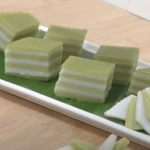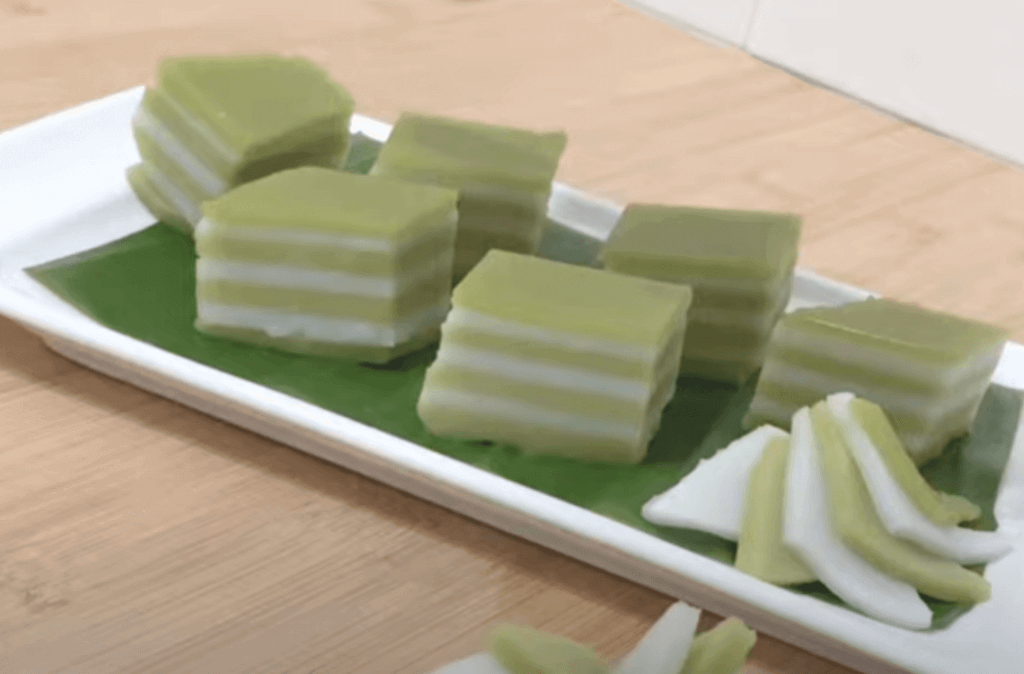Pandan leaves have a pleasant and sweet aroma. Here in Malaysia, we are very fortunate as it is very easily grown.
I always place a whole bunch of fresh pandan leaves in the car as an air freshener. Pandan leaves are also believed to repel insects. Though the leaves smell amazing, it also makes me hungry in the car, thinking of all the food flavoured with pandan leaves.
Pandan leaves are very versatile and we can do lots with them in the kitchen.
FLAVOURING
The juice or extract from pandan leaves add flavour and aroma to dishes.
WRAP
Used as a wrap for grilling or steaming meat or fish, it adds a floral-note to the dishes.
NATURAL INSECT REPELLENT
Pandan extract or tea can be sprayed around the house or onto our skin as a natural insect/mosquito repellent.
KUEH GENGGANG aka KUIH LAPIS PANDAN
Do you remember the Pandan Coconut Candy recipe I shared for Deepavali last year?
It was such a hit, in fact, it is a good idea to make that for the upcoming Hari Raya too.
Today, I am going to share how to make Kuih Lapis, but instead of using red food colouring, I’m going to substitute that with natural pandan extract.
The result is an amazingly fragrant and delicious steamed layered cake loaded with health benefits.
Adding pandan leaves to our diet helps discharge toxins and unhealthy substances from our liver and body.
It also helps bring down elevated blood pressure levels.
Kueh genggang is a traditional and popular Nyonya kuih or is also widely known as kuih lapis. It is extremely easy and economical to make. It is steamed layer by layer and that is how I eat it too – by peeling off layer by layer.

Kuih Lapis Pandan Recipe
Equipment
- Steamer
Ingredients
- 75 g Rice Flour x 2
- 75 g Tapioca Flour x 2
- 150 ml Water
- 150 ml Pandan Extract
- 450 ml Coconut Milk
- 130 g Sugar
- 1/2 tsp Salt
- 9-10 Pandan Leaves
Instructions
- Blend 7-8 pandan leaves in 150ml water.
- Strain to get pandan extract. Set aside.
- Pour 450ml coconut milk into a pot.
- Add 130g sugar and 1/2 teaspoon salt.
- Throw in knotted pandan leaves.
- Boil until sugar dissolves.
- Remove from heat and divide coconut mixture into two equal portions.
- In a bowl, combine 75g rice flour and 75g tapioca flour.
- Add 150ml water and stir.
- Add one portion of the coconut mixture and stir until no lumps.
- Strain batter.
- Divide the white batter into 3 1/2 portions and set aside.
- In another bowl, combine 75g rice flour and 75g tapioca flour.
- Add 150ml pandan extract and stir.
- Add the other portion of the coconut mixture and stir until no lumps.
- Add in the 1/2 bowl portion of white batter into the pandan batter and mix.
- Strain batter.
- Divide the pandan batter into 4 equal portions.
- Heat an 8-inch tray in a steamer.
- Pour the first pandan batter layer into the heated tray.
- Cover the tray with aluminium foil and steam for 5 minutes.
- Repeat with white batter and steam for 5 minutes.
- Continue with the third layer (pandan batter) and steam for 5 minutes.
- Next is the white layer again and steam this 4th layer for 5 minutes.
- The fifth layer is pandan batter and this time steam for 7 minutes.
- Continue with the white batter for the sixth layer and steam for 7 minutes.
- Next layer is pandan batter and this final layer requires a thorough steaming time of 15 minutes. Check the water level in your steamer as you may need to add water into it.
- Once done, remove from steamer and cool completely before attempting to cut the cake.
For more healthy and scrumptious recipes for your Ramadan and Raya, visit our Semangat Ramadan Raya page today!
